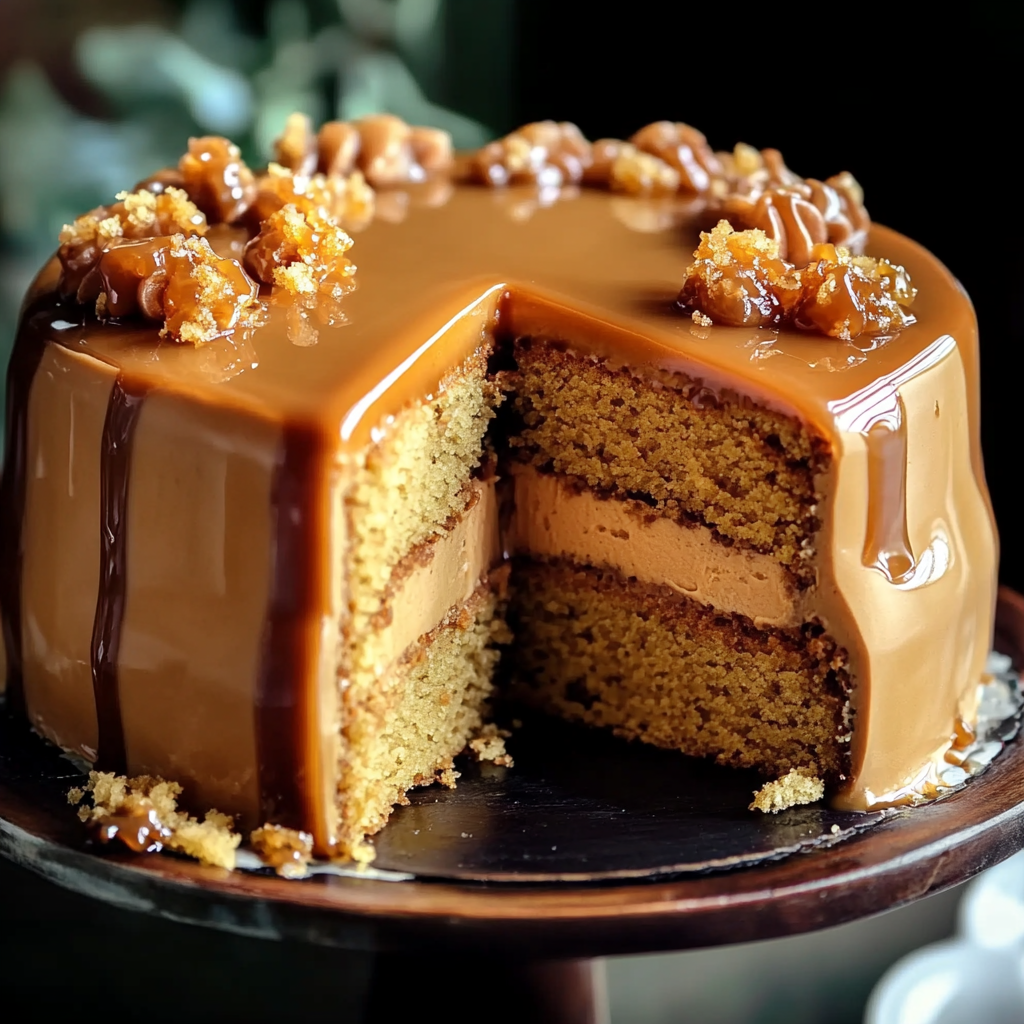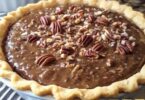Nothing says Southern comfort quite like a Southern Burned Caramel Cake. This old-fashioned dessert has been a beloved staple at family gatherings, church potlucks, and Sunday dinners for generations. The magic of this cake lies in its deep, caramelized frosting—a perfect balance of sweetness and smokiness that captures the essence of Southern hospitality.
In this article, you’ll learn exactly how to recreate this traditional favorite from scratch. Whether you’re baking it for a celebration or simply craving a taste of nostalgia, this guide will walk you through every step with warmth, ease, and a sprinkle of Southern charm.
1. Introduction to Southern Burned Caramel Cake
If there’s one dessert that perfectly embodies the warmth and tradition of the South, it’s the Southern Burned Caramel Cake. The name may sound intimidating, but don’t let it fool you—this cake is all about depth of flavor and homemade charm.
The combination of a soft, buttery yellow cake and rich, smoky caramel frosting creates an experience that’s both indulgent and heartwarming. Think of it as the culinary version of sitting on your grandmother’s porch on a summer evening—comforting, familiar, and just a little nostalgic.
2. The Story Behind the Southern Burned Caramel Cake
The origins of this cake go back generations in Southern kitchens. Before modern candy thermometers and electric mixers, cooks relied on instinct, patience, and a wooden spoon. The term “burned” doesn’t mean scorched—it refers to caramelized sugar, cooked until it develops a deep amber color that gives the frosting its signature flavor.
Families passed down this recipe through handwritten notes, old cookbooks, and cherished memories. Today, it remains a symbol of love, tradition, and Southern pride.
3. Why It’s Called “Burned” Caramel
Here’s the secret: “burned” caramel isn’t burned at all—it’s intentionally cooked just long enough to bring out the bittersweet notes of caramelized sugar. This process creates a bold, complex flavor that’s different from the typical caramel frosting you might find elsewhere.
Think of it like roasting marshmallows—there’s a fine line between “perfectly toasted” and “burned.” The goal is to hit that golden point where sweetness meets smoky richness.
4. Ingredients You’ll Need
Let’s start with the essentials. Below are the exact ingredients you’ll need to recreate this Southern classic.
For the Cake:
1 cup vegetable shortening
2 cups sugar
4 large eggs, room temperature
3 cups all-purpose flour
2 teaspoons baking powder
¼ teaspoon salt
1 cup whole milk, room temperature
2 teaspoons vanilla extract
For the Frosting:
½ cup sugar (for burning)
½ cup boiling water
4 cups sugar
2 sticks margarine
1 cup milk
1 teaspoon vanilla extract
These simple pantry staples combine to create something extraordinary—proof that Southern magic often starts with humble ingredients.
5. Step-by-Step Instructions for the Cake
Preheat your oven to 350°F (175°C). Grease and flour your cake pans.
Cream the shortening and 2 cups of sugar together until light and fluffy.
Add the eggs one at a time, beating well after each addition.
Sift the flour, baking powder, and salt together three times.
Add the dry ingredients to the creamed mixture alternately with the milk, beginning and ending with the dry mixture.
Stir in the vanilla extract.
Pour the batter into the prepared pans and bake for 30–35 minutes, or until a toothpick inserted in the center comes out clean.
Cool the cakes in the pans for 10 minutes, then remove and cool completely on a wire rack.
This cake bakes up tender, fluffy, and beautifully golden—the perfect canvas for your caramel frosting.
6. Step-by-Step Instructions for the Frosting
Burn ½ cup of sugar in an iron skillet over medium heat until it turns a deep amber color.
Carefully add ½ cup of boiling water to the burned sugar to make a syrup.
In a large saucepan, combine the burned sugar syrup, 4 cups sugar, margarine, and milk.
Cook over medium heat until it reaches the soft ball stage (about 235°F/113°C).
Remove from heat and add vanilla extract.
Set the pan in cold water and beat the frosting until thick enough to spread.
Frost the cooled cake layers generously.
The frosting is where the magic happens—it’s thick, luscious, and full of that caramelized depth that defines the Southern Burned Caramel Cake.
7. Baking Tips for the Perfect Texture
Room temperature ingredients are key. They blend better and ensure a smooth batter.
Don’t overmix the batter—mix just until everything is combined.
For extra moisture, consider brushing the cake layers with a little milk before frosting.
Always let your cakes cool completely before adding the frosting to prevent melting.
8. How to Make the Caramel Frosting Just Right
The secret to the perfect caramel frosting lies in timing and patience. When burning sugar, keep a close eye—it can go from golden to black in seconds. Stir constantly and add boiling water carefully (it can splatter!).
When cooking the frosting mixture, use a candy thermometer for accuracy. If you don’t have one, you can test it the old-fashioned way—drop a bit into cold water. If it forms a soft ball, it’s ready.
9. Common Mistakes and How to Avoid Them
Burning the sugar too much: If it smells bitter, it’s gone too far. Start over.
Not cooking the frosting long enough: This can make it too runny to spread.
Frosting too early: Always cool your cake completely before frosting.
Skipping the sifting step: It might seem optional, but sifting the flour ensures a light, airy cake.
10. Creative Variations to Try
Pecan Caramel Cake: Add chopped toasted pecans between layers.
Salted Caramel Twist: Sprinkle a touch of flaky sea salt on top for a modern touch.
Coconut Caramel Cake: Add shredded coconut to the frosting for a tropical flavor.
Mini Caramel Cupcakes: Turn this recipe into adorable cupcakes for parties or gifts.
11. How to Store and Serve Southern Burned Caramel Cake
Store the cake in an airtight container at room temperature for up to 3 days.
For longer storage, refrigerate for up to a week. Let it come to room temperature before serving.
This cake tastes even better the next day as the flavors meld beautifully.
12. Pairing Ideas: What to Serve With It
Pair your Southern Burned Caramel Cake with:
A cup of sweet tea (because, of course, it’s the South).
Fresh berries for a touch of brightness.
Or even a scoop of vanilla ice cream to balance that rich caramel flavor.
13. Why This Cake Feels Like Home
There’s something soulful about this cake. It’s not just dessert—it’s a piece of history. Each bite connects you to generations of Southern cooks who poured their hearts into every whisk, stir, and taste.
It’s the kind of cake that makes you slow down, gather with loved ones, and savor the simple joys of life.
14. Healthier Ingredient Substitutions
Want to lighten it up a little? Try these swaps:
Use unsalted butter instead of margarine for a richer, more natural taste.
Replace half the sugar with brown sugar for added depth and slightly less sweetness.
Use low-fat milk or almond milk if preferred.
Swap shortening for coconut oil for a lighter flavor and healthier fat content.
15. Conclusion
The Southern Burned Caramel Cake is more than just a recipe—it’s a sweet story told through generations. From its golden, tender layers to its unforgettable caramel frosting, every bite brings warmth, nostalgia, and a taste of Southern tradition.
So, roll up your sleeves, preheat your oven, and bring this timeless classic to your table. Whether it’s a holiday, a birthday, or just a Sunday afternoon, this cake will always steal the show.
FAQs
1. Why is it called Southern Burned Caramel Cake?
Because the sugar is cooked until it’s nearly “burned,” creating that signature smoky caramel flavor unique to this Southern classic.
2. Can I use butter instead of shortening in the cake?
Yes! Butter works beautifully and adds a slightly richer flavor, though shortening keeps the cake extra fluffy.
3. How do I know when my frosting reaches the soft ball stage?
Use a candy thermometer (235°F/113°C) or drop a bit into cold water—it should form a soft, flexible ball.
4. Can I freeze Southern Burned Caramel Cake?
Yes, wrap it tightly in plastic wrap and freeze for up to 3 months. Thaw completely before serving.
5. What makes this cake different from other caramel cakes?
The “burned” sugar technique gives it a deeper, more complex caramel flavor—bold, rich, and authentically Southern.







